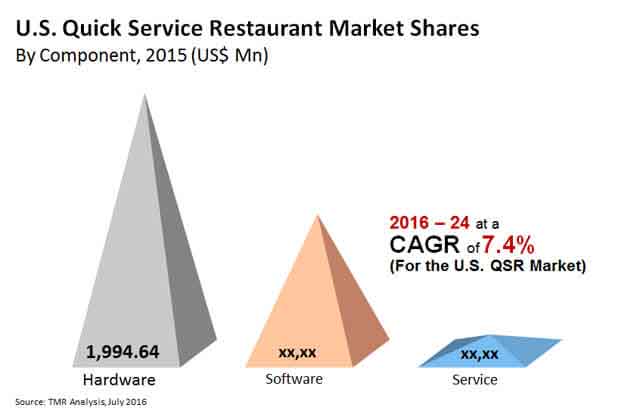Demand for Digitally Advanced Services From Tech-savvy Consumers to Drive U.S. Quick Service Restaurant (QSR) IT Market, reports TMR
The presence of a large number of software companies offering distinguished services to the quick service restaurant (QSR) industry in the U.S. has made the U.S. QSR IT market highly competitive, reports Transparency Market Research (TMR) in a recent report. The top five vendors in the market collectively accounted for a mere 25% in the overall market in 2015. To gain an edge, IT services and solutions providers for the QSR industry in the U.S. are continuously innovating and developing products capable of reducing turnaround times of services.
Innovations that can hit the right note with the country’s tech savvy consumers, making their dining experience not only quick but also memorable, are also being increasingly sought. Vendors in the market are creating long-term partnerships with large- and mid-sized QSRs to gain sustained returns in the intensely competitive market. The provision of IT solution in a single package or bundled services, with monthly or annual payment packages, is also emerging as a prominent trend in the U.S. QSR IT market.
Some of the key vendors operating in the market are NEC Display Solutions of America, Inc., Panasonic Corporation, HM Electronics, Inc., Oracle Corporation, NCR Corporation, PAR Technology Corporation, and Revel Systems, Inc.
Get PDF Sample for this Research Report @ https://www.transparencymarketresearch.com/sample/sample.php?flag=S&rep_id=13919

Rising Hourly Wages in the U.S. Trigger Adoption of QSR IT Solutions
The U.S. Bureau of Labor Statistics finds that the average hourly earnings of people working in the food services industry has increased from nearly US$11.54 in 2010 to US$13.33 in 2016. This trend in salary inflations is a prominent factor compelling QSR owners in making the shift from manual operations to machine-based automatic operations. In the next few years, IT solutions that can replace the need for manual intervention in QSR operations, such as digital kiosks, tabletop e-waiters, digital checkout counters, and digital menu boards will gain increased adoption. Hand-held devices, especially, such as tablets and smartphones, will gain increasingly prominent positions in the future IT-enabled QSR infrastructures.
Download Report TOC for in-depth analysis @
https://www.transparencymarketresearch.com/report-toc/13919
Need for Speed in Consumer Services to Stimulate Demand
With a continuous rise in the numbers of quick service restaurants in the U.S., the competition has also soared. Hence, ways of delivering best-in-class services and meeting consumer expectations are being pursued. This has driven the increased adoption of digital channels for transacting in quick service restaurants in the past few years in the U.S. market. QSRs in the country are updating their internal systems to make meal orders and payments compatible with near field communication and mobile wallets. Contactless payment solutions, which can immensely help smoothen transactions, are increasingly being tested by payment solution providers for creating quick payment options.
In the next few years, the rising number of smartphones users in the country is expected to make smartphones the central point of contact with consumers for the QSR industry. Thus solutions enabling purchasing, ordering, and payment using smartphones will be the most promising revenue generators.